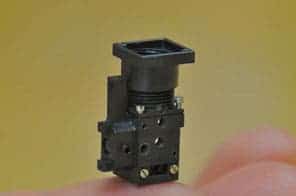A team of neuroscientists from Stanford University have managed to create a remarkably tiny device capable of monitoring brain activity in a rodent or other small animals. The device can be manufactured extremely cost-effective and might prove to be an invaluable tool for researchers of the new decade.

Mice have always been the lab subjects of choice, and besides running around mazes for cheesy treats, rodents have now a new reason to rejoice. I mean, what mouse wouldn’t love one of these beauts wrapped around its head? The tiny microscope, weighing only 2 grams, is capable of monitoring up to 200 individual brain cells as the subjects moves around its environment. That’s actually more than a very expensive lab-sized equipment can rend, which requires the subject not to move.
The device, in principle, works by detecting fluorescent light, often used in biological research to mark different cells. Due to its tiny size and weight it can be easily strapped on a mouse’s head and used to accurately determine its brain pattern. Mice could be drugged and thus researchers will be able to see at a cerebral level how it interacts with the subject, or better understand what regions of the brain are more active when a subject is performing a particular task. Applications are numerous.
The cost? Well, the development cost for the prototype is figured at $50,000, however future models could drop in price extremely. First of all, all its components are already mass-produced everywhere on the mobile market, especially its core component, a complementary metal-oxide-semiconductor (CMOS) sensor, which can be found in most modern cell phone’s camera.
“The massive volume of the cell-phone market is driving costs down while not sacrificing performance,” says Aydogan Ozcan, professor of electrical and biomedical engineering at the University of California, Los Angeles. “Scientists are realizing that with cost-effective compact architecture, they can have components that a decade ago would cost thousands of dollars, if you could find them.”
The team of researchers, lead by Mark Schnitzer, a neuroscientist at Stanford University, got the idea to create this device after they understood they need to manufacture their own microscope to study how the brain directs movement. In the process, they managed to create a highly feasible and lucrative device, which quite possible might become highly commercial appealling in the future. Schnitzer and colleagues have already established a small start-up with this in mind.
“The advancement in being able to make a fluorescent scope this compact is really significant,” says Daniel Fletcher, a bioengineer at the University of California, Berkeley, who was not involved in the research. “For the animal to be able to carry the whole microscope along with it opens a lot more possibilities in studying behavior.
The study was published in this week’s issue of Nature Methods.
via






